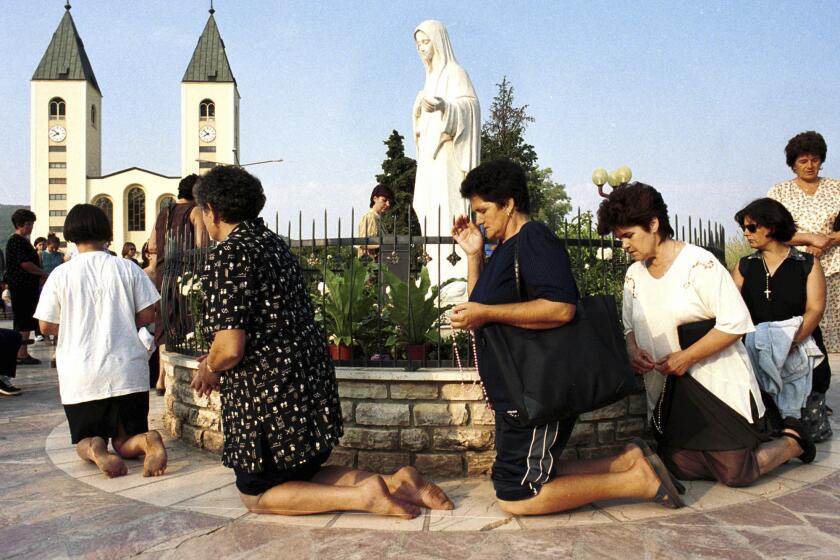Their Wish Is for Yuletide Clemency
Abbe Smith was a young law student when she first met Patsy Kelly Jarrett, who was in prison for murder. “I’m innocent,” Jarrett said. “Please help me.”
Twenty-three years later, Smith is still trying.
The 47-year-old law professor is working for a Christmas-season clemency for Jarrett, convicted in a 1973 murder in New York. She filed a 7-pound clemency petition, swollen with arguments for Jarrett’s release. The murder victim’s mother does not oppose the effort.
Over the years, Smith’s client has become a friend. She knows her shoe size and buys her sneakers.
“It’s a matter of conscience,” Smith said. “I know she’s locked up. I can’t forget about it. I can’t just say, ‘Life stinks,’ and move on.”
Jarrett was one of two people convicted in the murder of 17-year-old Paul Hatch as he worked the Saturday shift at a Seaway gas station near Utica, in central New York. Jarrett maintains that she was not at the gas station, but instead may have been sleeping or playing softball elsewhere in Utica at the time.
Jarrett and a male traveling companion from her North Carolina hometown were found guilty of murder and robbery in 1977.
At age 26, she was sentenced to 25 years to life. A 1979 prison escape -- she says she wanted to prove her innocence -- and a subsequent escape attempt added 3 1/2 years to her sentence.
Case closed.
Except that details of her prosecution have troubled some -- particularly the crucial eyewitness testimony of a gas station customer.
The customer, Robert Hyland, identified Jarrett during a trial more than three years later as the woman behind the wheel of another car at the pumps.
Yet two days after the killing, Hyland told police that although he thought that the driver was a white female, he wasn’t sure because the suspect’s long black hair obscured the face.
Jarrett’s supporters believe that another person was in the car.
The contentions are hard to refute so many years later. Hyland is dead, as is the prosecutor. State police investigator Ron Hojnacki stands by the work he was part of, saying it was “based on facts and investigative acts.”
Still, Jarrett’s conviction has haunted some people.
New York University law professor Claudia Angelos said the case weighs on her every day -- decades after she and her students failed to win Jarrett’s release. Angelos said she got the case when a former prison superintendent forwarded it to her.
Abbe Smith was among Angelos’ students who worked to free Jarrett. The law student from an affluent Chicago-area family connected with the friendly, working-class Southerner. Immersing herself in the case in 1980, Smith became convinced that Jarrett was innocent.
On a recent fall day, Smith came to the state Capitol with a briefcase of legal papers and several allies in another attempt to secure an early release for Jarrett.
With Christmas comes clemency season.
This is the third clemency petition that she has filed with Gov. George E. Pataki. The document includes results of a lie detector test that Jarrett passed and a 1982 affidavit from her co-defendant, serving time in Virginia for another murder, who swears that Jarrett was not with him that day near Utica.
“Abbe, she just never forgot me,” Jarrett said during a prison interview. “Abbe’s like my lifeline.”
Smith is used to longshot campaigns since canvassing for Eugene McCarthy’s presidential bid at age 12. She has had a thousand clients, but this case is different, a defining legal journey that reminds her of the “To Kill a Mockingbird” line: “Every lawyer gets at least one case in his lifetime that affects him personally.”
Clemency odds are lottery-like. Pataki gets about 500 applications annually and grants, on average, fewer than four, often to drug criminals. The governor’s office routinely does not comment on pending applications.
Paul Hatch’s mother, Ruth Hatch, 82, said she would not oppose clemency since it was the man, not Jarrett, who killed her son.
“I mean, if the pope can forgive the guy that almost killed him, I guess I can forgive her,” she said.
If this effort fails, Jarrett figures to be in prison long past her first parole date in 2005.
She could have been out a long time ago.
Angelos’ students won a round in 1986 in federal court and, as the government appealed, the prosecutor offered a deal: Plead guilty and get a sentence roughly equal to time served.
Rejecting emphatic advice to take the deal, Jarrett refused. She said it would be a lie.
“In my heart, I just couldn’t do it,” Jarrett said, her Southern accent worn down from decades in Bedford Hills state prison. “I can live with myself better in here.”
An appeals court reversed the 1986 decision, essentially sealing the prison doors for her.
Now 53, Jarrett has spent intervening years working with AIDS patients, studying the Bible and living a life she describes as stuck in time. She now goes by her middle name, Kelly -- saying Patsy, a name synonymous with chump, is dead.
As Jarrett sat, Smith soared as a defense attorney, a teacher at Harvard and a law professor at Georgetown. They stayed in touch. But the lawyer’s current round of work did not come until after 1993, when she spoke to Jean Harris, killer of “Scarsdale Diet” author Dr. Herman Tarnower, at a conference.
Harris knew Jarrett from Bedford Hills. She told Smith that “everyone” knew Jarrett was innocent.
“I think that made me feel ashamed that I wasn’t more actively involved,” Smith said.
In spite of themselves, both women show some hope as a clemency decision nears. Smith said a three-member state board questioned Jarrett in prison about her clemency request this month, a first for her.
If released, Jarrett said she would live at a local convent and tell young people to be careful about with whom they associate.
Smith said she’d do whatever it takes. “If she gets out,” Smith said, “I’ll be there to pick her up.”
More to Read
Start your day right
Sign up for Essential California for news, features and recommendations from the L.A. Times and beyond in your inbox six days a week.
You may occasionally receive promotional content from the Los Angeles Times.






